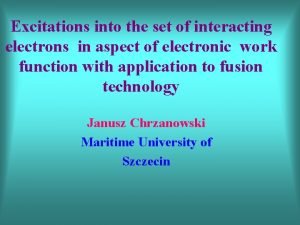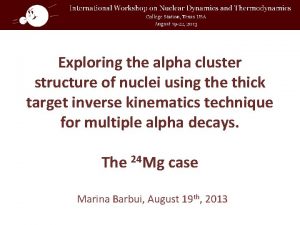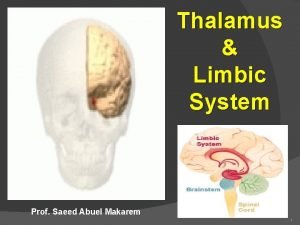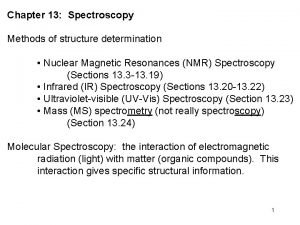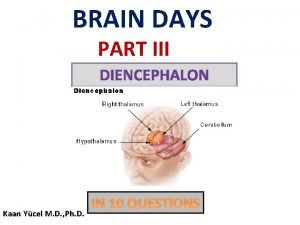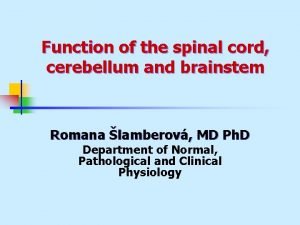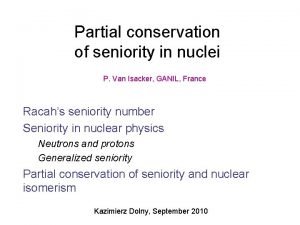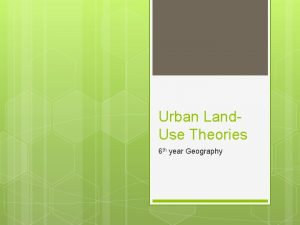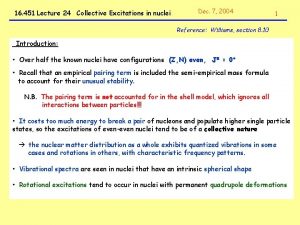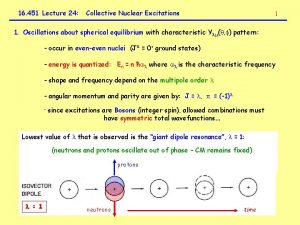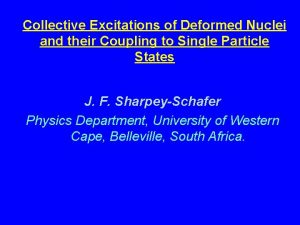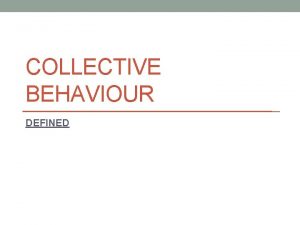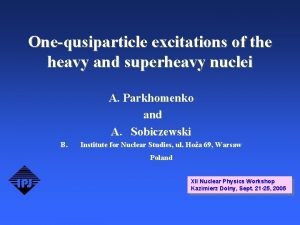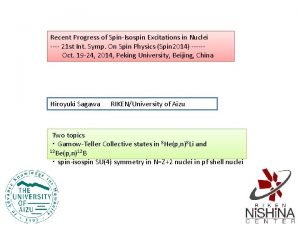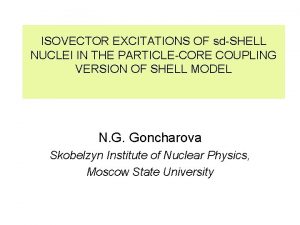16 451 Lecture 24 Collective Excitations in nuclei
















- Slides: 16

16. 451 Lecture 24 Collective Excitations in nuclei Dec. 7, 2004 1 Reference: Williams, section 8. 10 Introduction: • Over half the known nuclei have configurations (Z, N) even, J = 0+ • Recall that an empirical pairing term is included the semi-empirical mass formula to account for their unusual stability. N. B. The pairing term is not accounted for in the shell model, which ignores all interactions between particles!!! • It costs too much energy to break a pair of nucleons and populate higher single particle states, so the excitations of even-even nuclei tend to be of a collective nature the nuclear matter distribution as a whole exhibits quantized vibrations in some cases and rotations in others, with characteristic frequency patterns. • Vibrational spectra are seen in nuclei that have an intrinsic spherical shape • Rotational excitations tend to occur in nuclei with permanent quadrupole deformations

Vibrational states: 2 Model: quantized oscillations of a liquid droplet at constant density (why? repulsive short-distance behaviour of the N-N force!) Consider oscillations about a spherical equilibrium shape, with a time-dependent boundary surface expressed as a linear combination of spherical harmonic functions: expansion describes any shape at all, given appropriate coefficients. Each contribution can in principle oscillate at a different frequency. . Normal modes of the system correspond to excitations with a particular value of and , and these will occur at characteristic frequencies. Application to nuclei: 1. restriction to axial symmetry, i. e. = 0 2. vibrations are quantized: En = n ħ

Illustration: time sequence of oscillating nuclear shapes 3 forbidden – density change! = 0 forbidden – CM moves! protons = 1 neutrons time OK. . . = 2 = 3

“Giant Dipole Resonance” in Nuclei: J = 1 - “GDR” 4 • characteristic feature that can be seen in all nuclei • very short-lived state at high excitation • E 1 = ħ 1 78 A-1/3 Me. V (example below: 197 Au, E = 15 Me. V) • 6 Me. V (common feature) 10 -22 s • classical analog is an oscillating electric dipole moment – can decay via E 1 radiation pattern (signature) Electric dipole radiation pattern: Griffiths, Intro. to Electodynamics: z

Quadrupole oscillations occur at lower energy: J = 2+ = 2 5 time • typically, ħ 2 ~ 1 Me. V in a variety of even-even nuclei • excitation energy is low, so can expect to see up to several “quadrupole phonons” in the spectrum energy • Boson excitations, so require a symmetric wave function under exchange of “particle” (phonon) labels this restricts the total J , 2 ħ 1 ħ 0 e. g. for two phonons: 0+ , 2 + , 4 + 2+ 0+ Model spectrum

Example of vibrational excitations: 6 3 - state? 3ħ 2 multiple = 2 phonon states, ideally degenerate n = 2, J = 0+, 2+, 4+ 2ħ 2 (characteristic decay patterns: gamma-rays emitted with “E 2” angular distributions, like a quadrupole antenna) ħ 2 n=1, = 2, 2+ phonon (E-E ground state) E (Me. V) contrast, adding one neutron: 0. 29 11/2 0. 21 3/2 0 ½+ - +

The 3 - state is an octupole phonon, = 3: = 3 7 time • J = 3 • ħ 3 ~ (2 -3) ħ 2 ~ 2 – 3 Me. V • typically only see one octupole phonon per spectrum Summary: • low lying excitations in even-even spherical nuclei have the same characteristic pattern up to a few Me. V in excitation energy: 0+ (gs), 2+ (quadrupole phonon), (0+, 2+, 4+) (two phonons), 3 - (octupole)

2. Quantized Rotations in deformed nuclei: 8 Classical rotating object: dm Replace L with rotational angular momentum J: moment of inertia sets the scale of the energy level pattern allowed J determine a characteristic spacing pattern J is quantized; “rotational bands” are spectra characterized by a given value of the moment of inertia, I, and a series of energy levels with J = 1 or 2: • even-even nucleus: J = (0, 2, 4, 6, 8, 10. . ) = + • odd-even deformed nucleus: J = ½ integer, J = 1 within a “band”

Example: 9 176 Yb Quantized energy states of a rotating football! J Note -- larger I means smaller energy level spacing! note: rotations around the symmetry axis are indistinguishable; rotational angular momentum must be perpendicular to the symmetry axis.

The moment of inertia gives a measure of the nuclear shape: parameterize the shape, quadrupole moment and moment of inertia assuming constant density football shape: z 10 R( ) If the nucleus rotates like a solid: (rigid body model): If the nucleus rotates like a liquid drop: (rotating fluid model) reality is somewhere in between. . .

Evidence of “quasi-fluid” behaviour for rotating nuclei: 11 spectral analysis: a plot of E vs J(J+1) should give a straight line with slope ħ 2/2 I • confirmed for 174 Hf • but for 158 Er, the slope decreases (moment of inertia increases) with increasing J. . . J J(J+1) Like a rotating fluid: “centrifugal stretching” along the symmetry axis occurs for larger angular momentum!

State of the art: Excerpt from US Long Range Plan, p. 35 web link: see lecture 1 12

Quadrupole moments and types of excitations across the nuclear chart: lighter nuclei: small Q. E-E nuclei have vibrational states 13 Rare earth region: ~ 0. 2 – 0. 3, rotational spectra for E-E single particle states in a deformed potential for O-E Closed shell nuclei: spherical; O-E nuclei near closed shells are good “Shell Model” candidates. . .

14 Example – nuclear states from lecture 22: light nuclei, 1 valence nucleon - good shell model description odd-odd – more than one valence nucleon -- complicated!!! rotational spectrum vibrational spectrum

16. 451: The end of the Introduction! From the U. S. Long range plan : “Opportunities in Nuclear Science” (lecture 1): The nucleus is a remarkable quantal system displaying diverse and rare phenomena. Governed by the strong interactions among nucleons, nuclei exhibit correlations resulting in both single-particle and collective modes of excitation. Nuclear structure theory attempts to understand these excitations and the responses of nuclei to different external probes, within a coherent framework. This theoretical framework must encompass a wide range of energy and momentum scales for nuclei ranging from the deuteron to the superheavy elements. Theory strives to describe the structure and dynamics of these oftendisparate systems and to apply the understanding thus achieved to unravel some of the mysteries of the universe. .

Graduate Studies & Research • Astronomy & Astrophysics • Atomic & Molecular Physics • Condensed Matter & Materials Physics • Mass Spectrometry of Biomolecules • Medical Physics • Physics of Nanoscale Systems • Subatomic Physics CURRENT PROJECTS IN SUBATOMIC PHYSICS: theory of nucleon structure; symmetry tests of strong & weak interactions; nuclear astrophysics, precise atomic mass determinations; ion & atom trapping. . STRATEGIC LINKS: TRIUMF, Argonne & Los Alamos National Labs, Jefferson Lab, Max Planck Inst. . . Believe it or not, you are ready for Grad School – Department of Physics & Astronomy University of Manitoba Winnipeg, MB Canada R 3 T 2 N 2 www. physics. umanitoba. ca STUDENTS WANTED ! think about it!!! • 22 faculty + 21 adjunct faculty • ~ 40 graduate students • guaranteed financial support • no polar bears!
 Threshold frequency
Threshold frequency 01:640:244 lecture notes - lecture 15: plat, idah, farad
01:640:244 lecture notes - lecture 15: plat, idah, farad Sprawl geography definition
Sprawl geography definition Nuclei
Nuclei Multi nuclei zone model
Multi nuclei zone model Limbic system
Limbic system Preoptic area hypothalamus
Preoptic area hypothalamus Neuroscience
Neuroscience High n c ratio
High n c ratio Nmr active and inactive nuclei
Nmr active and inactive nuclei Diencephalon
Diencephalon Harris ullman multiple nuclei model
Harris ullman multiple nuclei model Atomic nuclei
Atomic nuclei Lemnisco laterale via acustica
Lemnisco laterale via acustica Site:slidetodoc.com
Site:slidetodoc.com Nuclei
Nuclei Multiple nuclei model
Multiple nuclei model
